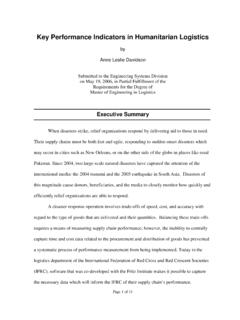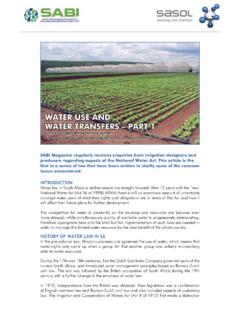Transcription of THE PATH FORWARD IN THE HUMANITARIAN SECTOR
1 FROM LOGISTICS TO supply CHAIN MANAGEMENT:THE path FORWARD IN THE HUMANITARIAN SECTORTABLE OF CONTENTSINTRODUCTIONThe Scope, Importance and Challenge of HUMANITARIAN LogisticsThe HUMANITARIAN ContextHUMANITARIAN LOGISTICS: CORE CHALLENGESTHE path FORWARDCONCLUSION: LEARNING AS THE BASIS FOR STRATEGIC CONTRIBUTIONAPPENDIXCase Studies on HUMANITARIAN LogisticsArticles on HUMANITARIAN Logistics123571314By Anisya S. Thomas, Director, Fritz InstituteandLaura Rock Kopczak, 2005 Fritz InstituteOn December 26, 2004, the earthquake in Sumatra and the destructive Tsunami that it unleashedriveted the attention of the entire world. Each day for the first two weeks, the toll of the deadand missing crept higher and heart-wrenching stories of devastated families beamed into the livingrooms of people in every country.
2 The response was immediate and unprecedented amounts of reliefmoney were the drama unfolded on television, the disaster relief infrastructure at the local, national andinternational levels sprang into action. Volunteers from the affected communities began to clear thedead, and relief agencies began to provide food and shelter to those made vulnerable. Internationalrelief agencies activated their assessment teams, and supplies to provide the basic necessities to largenumbers of people across a broad geographic span were ordered and transported from locationsaround the world. Unfortunately, disaster relief is and will continue to be a growth market. Both natural and man-madedisasters are expected to increase another five-fold over the next fifty years due to environmentaldegradation, rapid urbanization and the spread of HIV/AIDS in the developing world.
3 According tothe Munich Reinsurance group, the real annual economic losses have been growing steadily, averagingUS$ billion in the 1960's, US$ billion in the 1970's, US$ billion in the 1980's andUS$ billion in the 1990's. One of the notable aspects of the relief efforts following the 2004 Asian Tsunami was the publicacknowledgement of the role of logistics in effective relief. In the immediate aftermath of the Tsunami,as relief goods flooded airports and warehouses in the affected regions, aid agencies struggled to sortthrough, store and distribute the piles of supplies while disposing of those that were inappropriate. InSri Lanka, the sheer number of cargo-laden HUMANITARIAN flights overwhelmed the capacity to handlegoods at the airport.
4 Downstream, relief agencies struggled to locate warehouses to store excess inven-tory. In India, transportation pipelines were bottlenecked. In Indonesia, the damaged infrastructurecombined with the flood of assistance from the military representatives from several countries andlarge numbers of foreign aid agencies created a coordination and logistical nightmare. As a EuropeanAmbassador at a post-Tsunami donor conference said, We don't need a donors conference, we need alogistics conference. 1 Similarly, a spokesman for Doctors Without Borders, announcing their decisionnot to accept any more money for the relief operations, said What is needed are supply managerswithout borders: people to sort goods, identify priorities, track deliveries and direct the traffic of arelief effort in full gear.
5 2 HUMANITARIAN logistics, the function that is charged with ensuring the effi-cient and cost-effective flow and storage of goods and materials for the purpose of alleviating the suf-fering of vulnerable people, came of age during this Tsunami relief effort. Our research has shown, however, that only a handful of aid agencies have prioritized the creation ofhigh-performing logistics and supply chain operations. For most aid agencies, environmental factors,such as the unpredictability of disasters and the nature of funding, have resulted in operations withhigh employee-turnover rates, fragmented technology, poorly-defined manual processes, and a lack ofinstitutional learning over time.
6 As a result, relief operations are not as efficient and effective as theycould be and relief to beneficiaries is delayed or Understanding HUMANITARIAN supply ChainsINTRODUCTION1 New York Times, January 6, 2005. Global Agenda, January 5, paper provides background on the current state of logistics in the HUMANITARIAN environment andthe factors that have limited the evolution of knowledge and the performance of supply chains forhumanitarian relief. We consider the external pressures that aid agencies are feeling from donors, localhumanitarian organizations, governments and corporations, as well as the internal limitations that haveimpeded progress in logistics.
7 We then recommend five strategies that together define a path forwardfor aid agencies with regards to Scope, Importance and Challenge of HUMANITARIAN Logistics HUMANITARIAN Logistics is defined as the process of planning, implementing and controlling the effi-cient, cost-effective flow and storage of goods and materials, as well as related information, from thepoint of origin to the point of consumption for the purpose of alleviating the suffering of vulnerablepeople. The function encompasses a range of activities, including preparedness, planning, procure-ment, transport, warehousing, tracking and tracing, and customs clearance4. HUMANITARIAN Logistics is central to disaster relief for several reasons.
8 First, it is crucial to the effective-ness and speed of response for major HUMANITARIAN programs, such as health, food, shelter, water, andsanitation. Second, with procurement and transportation included in the function, it can be one of themost expensive parts of a relief effort. Third, since the logistics department handles tracking of goodsthrough the supply chain, it is often the repository of data that can be analyzed to provide post-eventlearning. Logistics data reflects all aspects of execution, from the effectiveness of suppliers and trans-portation providers, to the cost and timeliness of response, to the appropriateness of donated goodsand the management of information.
9 Thus, it is critical to the performance of both current and futureoperations and importance of logistics to HUMANITARIAN relief can be illustrated by the efforts of the InternationalFederation of the Red Cross and Red Crescent Societies (IFRC) to provide assistance to the Indian RedCross after the Gujarat earthquake. On January 26, 2001 a Richter earthquake struck Gujarat,where 41 million people were preparing to celebrate Republic Day in India. Thousands of people werekilled, the local airport was destroyed, the infrastructure severely damaged, and very little informationwas available in the early stages of the disaster. Nonetheless, within the first 30 days of the earthquake,along with the assistance of 35 partner organizations, the International Federation of the Red Cross'sLogistics Emergency Unit arranged the delivery of 255,000 blankets, 34,000 tents, 120,000 plasticsheets, and large quantities of other items such as kitchen sets that were distributed to beneficiaries bythe Indian Red Cross.
10 More than 300 other global, national, regional and local NGOs and UN agen-cies similarly mobilized their staffs and , the supply chain for relief is the ultimate sense-and-respond supply chain. Once a disasteroccurs, an aid agency sends in a team of experts to complete an initial assessment of the extent of thedamage and the number of people affected. The assessment forms the basis for an appeal that lists spe-cific items and quantities needed to provide immediate relief to the affected populations. Emergencystocks of standard relief items are sent in from the nearest relief warehouses. Calls are made to tradi-tional government donors and the public and commitments for cash and/or in-kind donations HUMANITARIAN supply Chains 23 The views presented here are based on extensive research conducted by Fritz Institute over the past three years, including case studies, interviews andconferences with the leading HUMANITARIAN relief organizations, technology and process development with select aid agencies.









